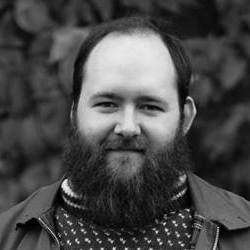Presentation
Concatenative programming sometimes feels like peeking into a mirror world, where function composition became the basic unit instead of function application. Familiar concepts glimmer with new and exciting reflections, and before you know it, it’s four o’clock in the morning, and you’re still struggling with making subtraction work.
Armed with the home-brewed language STCK, we’ll examine how Alonzo might have implemented booleans and numbers, if he had worked with a concatenative languages instead of lambda calculus. On the way we’ll learn about concatenative programming languages, and explore the deep relations between concatenative and functional programming.
You don’t have to know anything about concatenative programming to enjoy this talk, but some familiarity with lambda calculus might help.

Teodor works at Computas, where he’s currently busy telling everybody that Charles Moore ran a very successful consulting firm using Forth, among other things. He’s passionate about programming as an creative process, and he strongly belive that fun fosters innovation. When he’s not coding for hire, he enjoys making programs that run for a while and only makes the machine hot. In the future he hopes to eliminate this unfortunate side-effect as well.